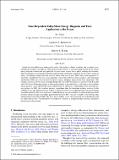Time-Dependent Eddy-Mean Energy Diagrams and Their Application to the Ocean
Author(s)
Thompson, Andrew F.; Flierl, Glenn Richard; Chen, Ru, Ph. D. Massachusetts Institute of Technology
DownloadTime-dependent eddy.pdf (1.886Mb)
PUBLISHER_POLICY
Publisher Policy
Article is made available in accordance with the publisher's policy and may be subject to US copyright law. Please refer to the publisher's site for terms of use.
Terms of use
Metadata
Show full item recordAbstract
Insight into the global ocean energy cycle and its relationship to climate variability can be gained by examining the temporal variability of eddy–mean flow interactions. A time-dependent version of the Lorenz energy diagram is formulated and applied to energetic ocean regions from a global, eddying state estimate. The total energy in each snapshot is partitioned into three components: energy in the mean flow, energy in eddies, and energy temporal anomaly residual, whose time mean is zero. These three terms represent, respectively, correlations between mean quantities, correlations between eddy quantities, and eddy-mean correlations. Eddy–mean flow interactions involve energy exchange among these three components. The temporal coherence about energy exchange during eddy–mean flow interactions is assessed. In the Kuroshio and Gulf Stream Extension regions, a suppression relation is manifested by a reduction in the baroclinic energy pathway to the eddy kinetic energy (EKE) reservoir following a strengthening of the barotropic energy pathway to EKE; the baroclinic pathway strengthens when the barotropic pathway weakens. In the subtropical gyre and Southern Ocean, a delay in energy transfer between different reservoirs occurs during baroclinic instability. The delay mechanism is identified using a quasigeostrophic, two-layer model; part of the potential energy in large-scale eddies, gained from the mean flow, cascades to smaller scales through eddy stirring before converting to EKE. The delay time is related to this forward cascade and scales linearly with the eddy turnover time. The relation between temporal variations in wind power input and eddy–mean flow interactions is also assessed.
Date issued
2016-09Department
Massachusetts Institute of Technology. Department of Earth, Atmospheric, and Planetary SciencesJournal
Journal of Physical Oceanography
Publisher
American Meteorological Society
Citation
Chen, Ru, Andrew F. Thompson, and Glenn R. Flierl. “Time-Dependent Eddy-Mean Energy Diagrams and Their Application to the Ocean.” Journal of Physical Oceanography 46.9 (2016): 2827–2850. © 2016 American Meteorological Society
Version: Final published version
ISSN
0022-3670
1520-0485